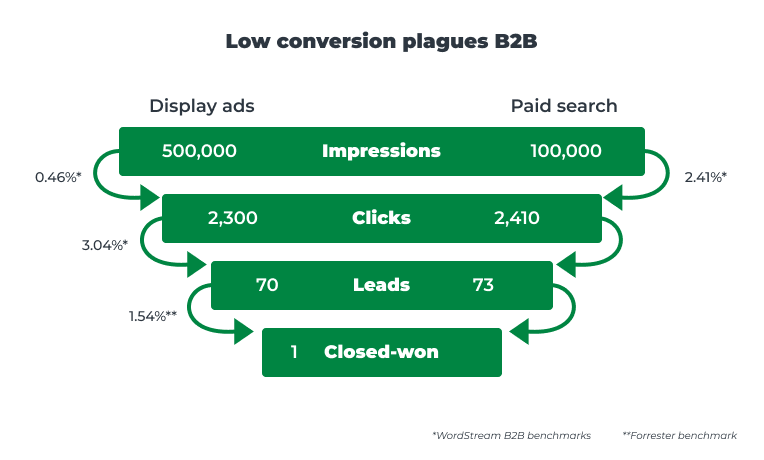Good news first: Advancements in B2B sales have a catalytic effect on humanity.
Who would’ve thought? Improving the ability of buyers and sellers of complex solutions to find each other more efficiently makes the world a better place. Whether your company is researching a cure for a disease, improving education or developing answers to environmental crises, products born from advancements in digital data will propel you to your moonshot better, faster and cheaper.
Think about how innovations from recent memory have already been used to impact your company’s bottom mission (and money): the introduction and embrace of social media strategy, account-based marketing, automation, retargeting, attribution models and funnel metrics…the list goes on.
With all these levers in place, why are even the best B2B companies still wasting massive amounts of money trying to find customers?
The bad news: Despite massive leaps forward in tools and processes, we’ve stalled at the most critical points: sales/marketing alignment, conversion and closing deals. Let’s explore the state of B2B customer acquisition.
The sad state of B2B customer acquisition
In one study, conversion benchmarks for B2B companies doing paid search and display ads (stats based on 14,197 US WordStream customers) saw:
- 2.41% click-through rate—the percentage of users who clicked on a paid search ad. In other words, 97.59% of people didn’t click. For display ads, the click-through rate is much worse, just 0.46%. That is, 99.54% of people didn’t click the ad. No wonder they call it banner blindness.
- 3.04% conversion rate—the percent of those clicking a paid search ad, sharing their identity and converting into a lead. That is, 96.96% of the visitors to your landing page leave without telling you who they are.
- 1.54% closed-won deals on MQLs. You would think, with all the upstream filtering, that the closing rate on marketing leads would be much higher, but it’s not. For that reason, the best companies use lead scoring to reduce the number of unqualified marketing leads sales receive. The best companies also have a dedicated team of inside sales people who just follow up and qualify scored marketing leads and then set up meetings for sales people.
What does that effort tell you about the quality of top-of-the-funnel marketing leads? It’s not a pretty picture.

Conversion rates are low and sales/marketing alignment remains a top challenge
Today, marketing sources 15-25% of the leads that sales needs to hit quota. In addition, the larger the organization, the lower the percentage of closed-won business.
As a result, salespeople spend 20% of their time prospecting, according to CSO Insights. If you multiply the sales budget by the 20% figure allocated by sales to prospecting, the dollar figure often surpasses the entire marketing budget. It’s not just the time investment, however. Time spent looking for prospecting robs sales teams of revenue capacity, so the problem of lead conversion has significant lost-revenue implications.
Additional benchmarks shed light on this problem. According to Salesforce, 12% of all leads convert into opportunities (higher than the Forrester MQL benchmark above). A Marketo study found that just 22% of sales qualified leads convert into closed-won business. Very few leads become sales opportunities or even sales qualified.
When you break out the prospecting function to a dedicated team who qualifies marketing leads and prospects on behalf of salespeople, the conversion rate picture doesn’t get that much better. A report by The Bridge Group reveals reps make an average of 40 dials per day, 10.6 attempts to reach a prospect and have 4.4 quality conversations per day. For teams delivering meetings, that activity level results in 19 meetings set per month, with 8.8 converting into opportunities. For teams providing sales reps with opportunities (i.e., which are more qualified than meetings), the monthly average was 12.5 per month, with 7.5 converting. That’s 1200+ phone calls to get 10 sales opportunities each month, per rep.
The impact of low yields on lead generation
The problem you’re facing is reduced sales productivity, even if you have a prospecting team and low returns on marketing investments.
This problem doesn’t just exist in old-school industries like heavy manufacturing and wholesaling. Peek at those darlings of innovation: the SaaS industry. Cross-functional resource allocation highlights just how much sales and marketing inefficiency is costing B2B customers and shareholders in that sector.
In a study by SaaS Capital, the percent of revenue allocated to functions like engineering, cost of goods, general and administrative, and customer support/success declines as a company grows, but not sales and marketing.
“Sales and marketing do not scale. Spending in these areas is at least 30% across all revenue levels.”

Industry leaders cite many factors for this poor performance. Sales methodology vendors believe improved sales training will make a big difference. Messaging consultants believe better messaging will win the day. Brand advocates believe a great brand advertising program will steal the spotlight. Sales and marketing technology vendors believe new technology is the answer.
These and other explanations clearly have merit in certain contexts. Anecdotes of success for these narrow remedies won’t solve the core problem. Identifying and dealing with root causes will.
The thought experiment
Everyone has their own idea about which levers to pull, and they all want to be the one to pull it. Efforts are spent in brand, messaging, sales training, etc., but with little or no impact.
What if the lever is in the customer’s hand all along?
Maybe it’s not about getting the right message into the right channel. Maybe it’s not about asking the right question at the right time. Maybe it’s not about name-recognition. Maybe it’s not about more technology. Of course, those things matter, but low conversion rates suggest something more fundamental is wrong.
What if these low conversion rates have more to do with the customer situation than your message, your sales and marketing channels, your brand recall, your sales skills, or your sales and marketing technologies? What if targeting could more precisely identify these situations?
There are many reasons most of the market won’t buy a B2B product or service. Some recently invested in an alternative solution. Others have a solution in place that is working sufficiently. Some can’t find what they need. Others tried a similar solution that didn’t work out and so are cautious. Others still have more pressing priorities, based upon their current situation. Many lack the resources (money, management attention, capabilities) to make the solution work. Most don’t even have the authority to buy. No message or cadence, regardless of the method of contact, will change the reality on the ground. As a result, many look but very few buy.
Between targeting the wrong accounts and soliciting those with no voice in decisions, is it any wonder conversion rates are low, and sales and marketing alignment is still a top challenge? The implication of this sober view of the conversion funnel is that something is fundamentally wrong with the ability of sales and marketing to target the right accounts.
Better targeting, then, is the absolute-must application for investment in artificial intelligence in your coming quarters.
The solution: Invest in AI for the right data
To transform data into actions, leading companies are using machine learning, predictive analytics, natural language processing and other techniques enabled by artificial intelligence.
Most of us experience the benefits of artificial intelligence in our own shopping experiences, such as when we get a ride with Uber, find a movie on Netflix or book a room on Airbnb. The success of B2B giants like Facebook and Google, however, should be a wakeup call to every B2B CEO in the world. Effective use of big data and data science is far more predictive of financial viability than many traditional balance sheet and operating income line items.
The long and short of it: AI can produce better targeting, the immediate solution to your bottlenecks in B2B sales.
Here’s how it works.
Mining the right data using AI produces what are called “lookalikes.” Consider these the hyper-focused prospects just ready to be introduced to your B2B sales funnel. Finding your next best customer is made simple through sophisticated pattern matching that prioritizes the right data at the right time, making closing deals that much easier. It’s seeing who’s a good person to purchase before they even know to show intent.
As Joël Le Bon, Ph.D., says in the foreword to AI for Sales, “In sales, time kills deals. In modern sales AI kills time!” We would add it dramatically reduces the overwhelming efforts to further align sales and marketing and makes the whole machine run smoothly.
To see how investing AI can improve your entire funnel, set up a demo.


